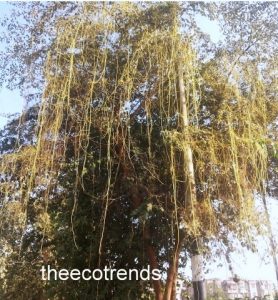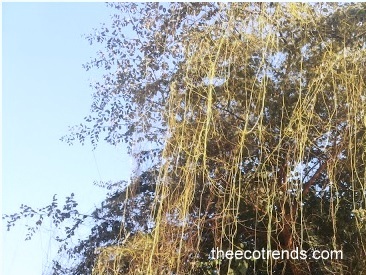We often see an interesting net of thread like structures on a plant. It is called as Amarbel in Hindi and dodder in English. In taxonomy its genus is Cuscuta, which contains up to 170 species. It belongs to the family of Morning Glory or Convolvulaceae.
Cuscuta is found throughout the temperate and tropical regions of the world. It has great species diversity in subtropical and tropical regions of the world. It has many folk names like wizard net, devil’s hair, goldthread, hair weed, love wine; strangle weed, angel’s hair, and witch’s hair.
This plant has thin stem which appears leafless, although it has minute scales that may be termed as leaflets.
The Cuscuta plant is distributed worldwide. In India about 6 species of this plant are found. It has no chlorophyll and cannot make its own food by photosynthesis.
It grows on thorny or other shrubs, sometimes completely covering the bushes or trees. It spread from one host to another, and on each victim, its branches twine and cling tightly with special branching organs called haustoria.

Seeds of Cuscuta have hard coating, and survive in the soil for 5-10 years or more. They sprout at or near the surface of the soil. The germination of seeds can occur without a host and for this it has to reach a green plant quickly.
The herb grows towards the smell of nearby plants. If the host contains food which is beneficial for it, then it produces haustoria that enter into the vascular system of the host and then its original root dies off. It can grow and attach itself to multiple plants.
Haustoria penetrate the host and connect to the host xylem as well as to the host phloem and absorb from it both water and elaborated food stuffs such as sugar and amino acid. It lives its entire life without attachment to the ground and grows with the help of seeds which are minute and produced in large quantities.
Many countries have laws to check the import of grains containing seeds of this plant.
Medicinal Properties of Cuscuta Plant
In China and in many Asian countries the extract of the Cuscuta plant is administered for the treatment of Osteoporosis. The Cuscuta reflexa is reported for antitumor, antimicrobial, hepatoprotective, anticonvulsant, antioxidant, induced alopecia etc. activities.
Many chemical constituents have been isolated from Cuscuta reflexa. Some of these are cuscutin, amarbelin, beta-sterol, stigmasterol, myricetin, qurecetin, cuscutamine, luteolin, bergenin etc.
Amarbel is also reported to treat baldness and piles. For the treatment of baldness a paste of the plant is applied on the head. For piles its extract is reported to be taken in.
Key Words: thread like, Convolvulaceae, haustoria, parasite




